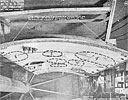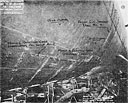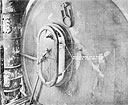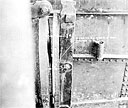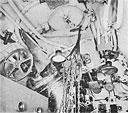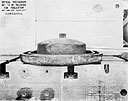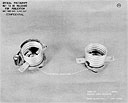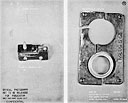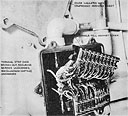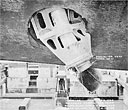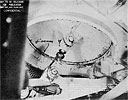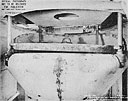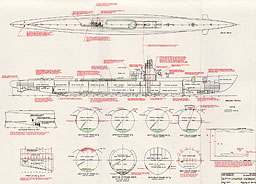HyperWar: War Damage Report 58: Submarine Report [Section V] (original) (raw)

Section IV
U.S.S.Kingfish (SS-234)
Depth Charge Damage
Off Formosa
23 March 1943
Class SS-212 Builder U.S. Navy Yard, Portsmouth, N.J. Commissioned 20 May 1942 Length (Overall) 31 ft. 8 in. Beam (Extreme) 257 ft. 3 in. Submergence Depth Designed Maximum (Axis) 300 ft. Displacements Standard Emergency Diving Trim Submerged Draft (Mean, Emergency Diving Trim) 16 ft. 10 in. Type of Propulsion Diesel Electric Reduction Drive Main Engines (4) Fairbanks-Morse 38_D-8-1/8 Main Motors (4) and Generators (4) Elliott Co. References: (a) C.O. Kingfish conf. ltr. SS234/A12-1/A-16-3/A9 of 8 April 1943 (Report of War Patrol Number Three). (b) Comdt. Navy Yard Mare Island conf. ltr. SS234/L11-1 (33-558674) of 17 May 1943 with enclosures thereto (Supplementary Report on Kingfish War Damage. (c) BuOrd (Re6) Memorandum dated 4 May 1943 (report on Inspection of Kingfish Damage and Interview of Ship's Officer's by Dr.A.B. Focke). Photograph Nos. 5-1 through 5-16 (furnished by Navy Yard, Mare Island). PLATE V
--26--
5-1. On 23 March 1943, while on her third war patrol, _Kingfish_underwent a severe depth charge attack north of Formosa. A total of over forty depth charges were dropped in the vicinity of _Kingfish_during the 71/2-hour period she was under attack. Serious damage was caused by the final pattern of six charges, two of which detonated close over the after portion of the ship while the boat was running at 300 foot depth, forcing her to the bottom in 350 feet of water. In spite of sustaining considerable permanent pressure hull deformation in various areas and widespread interior damage, no vital systems or machinery were put out of commission and watertight integrity remained substantially intact. Six hours after the termination of the attack, and without undue difficulty, Kingfish was able to surface and clear the area at full power on all main engines. This report is based on the information contained in the references and on an informal interview with the then Commanding Officer. The photographs were furnished by the U.S. Navy Yard, Mare Island. The Plate was prepared by the Bureau from data contained in the enclosures to reference (b).
5-2. Kingfish arrived at Pearl Harbor from her second war patrol on 23 January 1943. Normal refit was undertaken by repair forces of the Submarine Base, Pearl Harbor, and completed on 7 February. Deperming, sound tests and training were completed on 15 February and, on 16 February, Kingfish departed Pearl Harbor for Midway, arriving on 20 February. Minor voyage repairs were made there and fuel and lubricating oil were topped off. She departed Midway on 21 February for her third war patrol and arrived on station in the waters adjacent to the Island of Formosa on 7 March, destroying a 250-ton enemy trawler by three-inch gunfire attack on 4 March while en route. On 17 March, Kingfish sank a medium-sized freighter by two torpedo hits during a night submerged periscope attack, and on 19 March sank a medium-sized troop transport by two torpedo hits during a daylight submerged periscope attack. Three other attacks were made but no hits were obtained, apparently due to faulty torpedo performance.
5-3. At 0300 on 23 March, while surfaced about 60 miles north of Formosa, lat. 26°20'N., long. 121°55'E., Kingfish sighted at a range of approximately 5,000 yards what appeared to be either a small Japanese destroyer or minelayer of about 1,200 tons. Battle stations were manned at once and an attempt was made to gain a position ahead of the enemy ship for a dawn attack. However, at 0325, the target ship detected Kingfish and headed toward her at a speed of about 16 knots. Kingfish was able to draw away slowly at flank speed but twenty minutes later, at 0345, the enemy illuminated her with a searchlight. At this point, Kingfish submerged to a depth of 250 feet, rigged ship for depth charge attack and silent running, and commenced evasive action.
5-4. These maneuvers were unsuccessful, however, for at 0448_Kingfish_ received the first of a long series of depth charge attacks.1
--27--
Evasive tactics were continued at a depth of 300 feet, but the enemy was both tenacious and experienced, and seemed to have no difficulty maintaining contact. He appear to use sonic listening for determination of azimuth and echo-ranging for distance. Sound conditions were excellent. Three attempts were made by Kingfish to approach the surface and fire circular run torpedo shots, but each time the enemy counterattacked before a depth of 100 feet was reached, and this plan had to be abandoned. At 0752, the screws of a second ship were heard. This vessel took no direct action, apparently having no depth charges, and used no sound gear other than a fathometer. A total of 41 depth charges in eight separate patterns were dropped during the entire 71/2-hour period Kingfish was under attack. Attacks were spaced at about one hour intervals and consisted of from 3 to 8 charges each.
5-5. No serious damage was sustained until the final attack at 1227, at which time a pattern of six depth charges was received very close aboard while the ship was running at 300 foot depth. The charges were dropped in pairs, the first two detonating over the after portion of the ship, dishing the pressure hull and forcing Kingfish to the bottom in about 350 feet of water. The second pair of charges detonated forward of and above the ship causing but little damage. The third pair of charges was delayed nearly a minute and detonated forward, also causing only minor damage. Following this attack, the enemy vessels stayed in the vicinity for several more hours, occasionally making transits across Kingfish, but did not drop any additional charges.
5-6. The two close detonations aft, at 1227, caused severe vertical flexural vibrations of the hull as a whole. Reference (a) reports that the ship "humped like a measuring worm" and was forced considerably off her course. Reference (c) notes that there were "three strong up and down vibrations, followed by gradually decreasing ones". This type of vibration had not been observed during any previous depth charge attacks experienced by Kingfish. The motions were of such magnitude as to throw two men from their bunks to the deck and other personnel lost their footing even though braced in anticipation of shock. Some 12 of the 41 charges dropped on Kingfish were close enough to cause at least minor damage. The more distant of these 12 charges broke lights, stopped clocks, jarred cork insulation from the hull and, in general, caused lightly attached hull fittings to come loose. Closer-in charges caused numerous hull valves throughout the boat to open. Two observers claimed to have seen flame shoot past the breech door of one of the after torpedo tubes coincident with the detonations of the two very close depth charges aft. Smoke and fumes were also detected in the after torpedo room.2
5-7. All of the depth charges dropped by the enemy were probably of the Type 2, Mod. 1 design containing 357 pounds of Type 98 explosive. The two close detonations aft at 1227, which were responsible for most of the damage, are believed to have been centered as follows: one charge at the after end of the ship about ten feet above the deck level, causing the phenomena observed at the torpedo tube and forcing the
--28--
stern down with resultant plating failure under compression at the lower outer hull between frames 103 and 108; the second charge approximately 40 feet directly above the hull at about frame 83, causing the pressure hull structural deformation which occurred in way of the forward engine room.
5-8. Upon being forced to the bottom, the ship was silenced completely and, while awaiting darkness, the crew made temporary repairs to damage where feasible. Plans were prepared for scuttling ship in case escape proved impossible after surfacing. In partial execution of these plans, the ECM was destroyed and the torpedo data computer was rendered inoperative by disabling the forward angle solver. Only two after effects of the attack caused serious concern at this time. The first was the profuse leakage of sea water which occurred in both engine rooms through the distorted engine induction hull valves, the external induction system having completely flooded. This leakage was almost completely stopped within 15 minutes by forcing the valves hard against their seats with the aid of chain falls. The second was the high pressure air leakage into the boat through a damaged fitting in the No. 3 air bank piping and at partially opened cone joint connections at the high pressure air manifolds in the control room. The air pressure within the boat increased markedly as a result of this leakage. Since all manometers and barometers were disabled, the amount of increase in air pressure could not be determined, but calculations indicate that it was of the order of eight or more pounds per square inch.
5-9. At 1500 and again at 1800, the screws of an enemy vessel were heard plainly through the hull for periods of about 15 minutes although no more depth charges were dropped. At 1848, after dark, _Kingfish_manned battle stations and surfaced. A patrol vessel of about 1,000 tons was sighted lying-to approximately 2,000 yards off the starboard bow. No difficulty was experienced in immediately getting underway and the area was cleared at flank speed using all four main engines. Fortunately no opposition was encountered from the enemy patrol craft.
5-10. Since the damage made further offensive action impossible,Kingfish returned to base for repairs, arriving at Pearl Harbor on 9 April 1943. The return run was made submerged during daylight hours for the first two days. The only difficulty encountered in these submerged operations was the minor leakage into the engine air induction system and the complete flooding of the ship's supply ventilation system outboard piping which occurred on each dive.
5-11. Damage to the ship was of varied nature and of general extent throughout (Plate Vand Photos 5-1 through 5-16, but was most severe in the vicinity of the forward and after engine rooms, conning tower, and after torpedo room. Structural damage in these areas consisted of minor distortion to the circularity of the pressure hull and numerous depressions of the hull plating between frames. Damage in way of the engine rooms extended from frames 77 to 93, with the more
--29--
severe depressions occurring in the upper pressure hull plating between tank tops from frames 80 to 87. Depressions of 11/4 inch maximum depth occurred at frame 86 on the forward engine room riveted access patch, and between frames 82 and 83 (Photos5-1 and5-3. The keystone frame connections at frames 85 and 86, in way of the hard patch, pulled lightly apart due to depression of the hull in this vicinity (Photo5-2). Although the riveted butt and seam connections appeared to be the weakest points of this hard patch, it is significant to note that only minor leakage developed around the rivets in spite of the considerable distortion and impact to which this region of the hull was subjected. Small leaks also developed around the forward and after battery compartment bolted access patches, although these were remote from areas of hull damage. Except for the minor distortion which occurred to frame 83 (Photo5-3), all frames appeared to retain their proper shape.
5-12. Local depressions of the outer shell plating up to a maximum depth of about 1 inch occurred between frames, port and starboard, in way of three after lubricating oil tanks as follows; motor and reduction gear lubricating oil sump tanks Nos. 1 and 2, "A" strake (30-pound MS) between frames 103-105; motor and reduction gear lubricating oil stowage tank, "A" strake (30-pound MS) between frames 105-107; engine lubricating oil stowage tank No. 5, "B" strake (20-pound MS) between frames 107-108 (PLATE Photo 5-4). These areas are subject to full sea pressure and were structurally somewhat weaker than corresponding outer hull structure in way of the auxiliary and safety tanks. The depressed areas of the "A" strakes between frames 104-106 occurred in 30-pound plating backed by frames spaced on 30-inch centers instead of 24-inch centers as in the auxiliary and safety tanks and the "B" strake depressions between frames 107-108 occurred in way of 20-pound plating on 24-inch frame spacing instead of 30-pound plating as in the safety and auxiliary tanks.3The deformations in these areas could have been caused by either direct explosive loading from a close detonation or, possibly, as a result of the strong flexural vibrations reported by the ship, the depressed area occurring at the quarter length or natural node of vibration of the ship's structure as a whole.
5-13. Farther aft, minor depressions occurred in the shell plating just above the stern tubes, port and starboard, and the top of the after trim tank was indented to a depth of approximately 1 inch in two small areas, port and starboard, between frames 127 and 128. The trim tank depressions were located at the points where the port and starboard propeller guard struts had been originally attached. These guards had previously been permanently removed on Kingfish when it was found that the plating in way of the strut attachments had cracked, due to vibration. The cracks were welded up and covered with small doubler plates, causing local hard spots in the structural continuity, and this probably accounted for the local deformation at those points. The trim tank did not leak, however.
--30--
5-14. Investigation of the ship's structure in the after torpedo room disclosed minor variation from the designed offsets and the top of MBT No. 7 was dished upward between frames 110 and 118 to a maximum of 15/32 inch. No evidence of buckling of the tank top stiffeners could be found, however. The movement of the tank top forced the torpedo stowage and loading tracks out of alignment with the torpedo tubes to such an ]extent that they later had to be cut adrift and reset. The MBT No. 1 tank top plating in the forward torpedo room was also pushed upward, but to a lesser extent. However, realignment of the forward torpedo tracks was also found necessary in order to secure satisfactory torpedo handling and loading.
5-15. Both the end bulkheads and shell plating of the conning tower cylindrical structure sustained permanent deformation. The conning tower bulkheads installed on Kingfish at this time were of the type having a 15-pound medium steel inwardly dished plate acting as the bulkhead proper with a heavy forged ring connecting the periphery of the dished plate to the cylindrical wrapper plat (Photo5-5). It was reported by the ship's officers that the forward bulkhead was initially forced in to such an extent that the steering wheel moved approximately two inches aft relative to the lockers on the port side, and that the locker drawers could not be opened due to interference with the wheel. During the trip back to base, however, the ship reported that the amount of bulkhead deformation gradually reduced until, upon arrival, it was only about one-third the original amount. Offsets taken at the Navy Yard, Mare Island, one month after the damage occurred indicated a variation 3/4 inch at the after bulkhead. These figures mean little, however, since the dished plates are frequently shaped with at least that much deviation from the designed radius of curvature.4No means were available for determining the actual bulkhead offsets as originally fabricated and installed at the building yard. It is certain, however, from the known change which occurred in the relative positions of the steering wheel and lockers, that the forward bulkhead was deformed considerably.
5-16. It is interesting to note that the 20-inch by 38-inch six-dog watertight escape door fitted in the after bulkhead of the conning tower remained substantially intact and that no leakage occurred in spite of the probable large bulkhead deflection. The door frame was sufficiently distorted, however, so that the door dogs bound against the seat and prevented the door from opening more than a few inches (Photo 5-5). It was fortunate that the door seat was wide and flat, for had it been narrow or rounded, as was the case with earlier designs, the door gasket very probably would have been cut or blown out when the bulkhead deformed and serious leakage into the conning tower would have resulted.5
--31--
5-17. The conning tower plating was slightly deformed at the top after portion of the cylinder. The maximum depression occurring in this region was only 3/8 inch, located between the after bulkhead forged ring and the hoop stiffener just forward. Cork insulation under the depressed areas was cracked and loosened.A check of the general circularity of the conning tower cylinder showed that it conformed to the designed allowable diametrical tolerance of one-half the plate thickness.
5-18. Damage to structure and fittings external to the pressure hull was negligible. Two eyeports in the pilothouse were shattered and the light access door leading from the pilothouse to the forward gun platform was sprung so that it was difficult to close. The after torpedo room deck loading skid was jarred loose and lost overboard. No other damage worthy of mention was sustained by the superstructure, conning tower fairwater or bridge.
5-19. Damage to external hatch covers occurred in only two places. The forward escape trunk upper hatch cover was warped downward sufficiently to partially unseat itself and the trunk completely flooded. The hatch dogging mechanism was also bent, apparently when the cover was forced up under the action of one or more depth charges. Although the trunk flooded, the lower hatch held tight and no water entered the ship. No damage was sustained by the after watertight door of this escape trunk. The upper conning tower hatch cover seat was found to be distorted slightly but no leakage occurred. An interesting minor effect of depth charge impact was that the pins securing the upper handwheels to the squared ends of the worm shafts sheared off on both the forward and after escape trunk hatches. Aside from the conning tower bulkhead door frame, previously mentioned, no other damage occurred to external hatches, seats, gaskets or operating gear. However, the transverse struts fitted at the forward and after torpedo loading hatch bosses showed evidence of excessive compression, for their threads were jammed together to such a degree that subsequent removal was difficult. Three covers on topside pressure-proof ammunition stowages were distorted sufficiently to permit the stowages to flood. These were the two 3-inch/50 cal. ready service ammunition stowages located in the forward end of the conning tower fairwater and one 20mm ready service stowage located on the bridge (Photo 5-6).
5-20. There was considerable leakage of water into several interior compartments, but due to prompt damage control measures, at no time throughout the attack did flooding endanger the safety of the ship.Leakage occurred as follows:
(a) Into the forward torpedo room to a depth of 2 inches over the top of MBT No. 1 through a sound projector electrical cable hole.
(b) Into the pump room to a depth of 4 inches through the SJ radar mast stuffing box, the conning tower voice tube and an electric cable to the bridge, all of the water draining down from the conning tower bilge.
--32--
(c) Into both engine rooms to the level of the lower floor plates through the main engine air induction hull valves.
(d) Into the motor room through the starboard stern tube stuffing gland to a level 2 inches below the lower flat. This stuffing gland had been leaking heavily due to slight bending of the propeller shaft on a previous patrol. A close depth charge detonation aft, however, fortunately caused the packing to seal tight so that no further leakage was experienced while the boat was on the bottom. Simultaneously with this close detonation, two observers claim to have seen "a ball of fire" enter through the starboard stern tube.6
(e) Into the maneuvering room through the crew's water closet when the after sanitary tank No. 3 flooded due to its sea valve opening slightly under depth charge impact.
The maneuvering room leak, item (3), would not have occurred if the head flapper valve had not been open to receive water bailed from the engine rooms. Leakage in the forward torpedo room was caused when a parted cable to the port sound head was forced up through its stuffing tube into the ship by external water pressure. This leakage was stopped by driving a wooden plug into the cable hole and securing it with clamps (Photo 5-7). The water was removed by bucket brigade to the officers' shower and by the drain pump. A further troublesome source of leakage was caused by discharge of fuel oil into the engine room upon each close depth charge detonation. Pressure built up in the collecting tank through the compensating system stand pipe and opened the inboard relief valve, thus allowing oil to enter.
5-12. The most serious leakage was that which occurred in both engine rooms when the outboard engine air induction piping flooded and water leaked by the inboard valve seats which had been slightly distorted due to pressure hull deformation. The forward engine room induction hull valve seat was forced out of round by 1/4 inch athwartships and the after engine room induction hull valve seat was forced out of round 1/4 inch fore and aft (Photo 5-15). The exact manner in which the topside induction piping became flooded is not known since a test of this system at the Navy Yard, Mare Island, disclosed no leaks and the outboard mushroom valve closed satisfactorily even though its stem was slightly bent (Photo 5-16). It is of the following two ways; (a) fluttering of the outboard mushroom-type valve during successive close detonations, (b) temporary distortion of the main induction valve trunk while the valve was forced up during one of the detonations with subsequent eccentric seating of the valve when it came down again. This latter hypothesis might also account for the bent valve stem of the outboard induction valve. Personnel in the conning tower reported hearing air venting from the system. Leakage into the engine rooms was controlled after 15 minutes by taking up hard on the inboard valves with chain falls (Photo 5-8). Water in the forward engine room was discharged through a hose connection to the trim line while that in
--33--
the after engine room was cleared by forming a bucket brigade to the maneuvering room head in addition to using the trim and drain pumps. On later dives during the trip back to base, the induction system leaked a small amount, indicating that the induction outboard valve was not at this time seating properly. The ship's supply ventilation system piping also flooded on each dive and again no reason was evident. The hull valve for this system remained tight, however, and no inboard leakage occurred.
5-22. It was probably very fortunate for Kingfish that the bottom was close and at only 350 feet depth, for had she been in deep water and therefore required to continue operating, the increase in weight of approximately 9 tons of water taken into the engine induction and ship's supply ventilation piping topside would almost certainly have caused her to lose depth control, as in the case of_Scamp_ (SS277) and_Salmon_ (SS182). With enemy surface vessels overhead, an inadvertent rise to shallow depth or a possible broach might very well have proved fatal.
5-23. Damage to the main propulsion plant was very minor. There was some slight misalignment of the main reduction gears, resulting in an opening of .035 inches at the top of the starboard gear coupling and .030 inches at the top of the port gear coupling. Both the main motors and main reduction gears were rechocked during the subsequent overhaul. It was also discovered during the overhaul that the forward end-bells on all four main motors had been dished out such that offset oil-seal rings had to be manufactured for the forward bearings, the offset varying from 1/8 to 3/16 inches. The starboard shaft was bent approximately .180 inches but was straightened during the same overhaul without difficulty. Practically all holding down bolts and studs on the main and auxiliary machinery were stretched, although the nuts were still tight, indicating that this stretching probably was caused by excessive tightening during the original installation> There was no shearing of holding down bolts, studs or dowels. The circulating water pump attached to no. 12 service air compressor came loose due to the securing bolts backing off, but no further damage resulted. Excessive pressure on the valve disc of No. 1 outboard exhaust valve distorted both the disc itself and the seat (Photo5-9). The disc was renewed and the seat had to be remachined. Lubricating oil piping in the maneuvering room developed serious leakage when flanges partially opened.
5-24. Damage to electrical equipment and systems was also quite minor. Direct damage was sustained by phenolic fixtures, terminal strips, contact makers, connection boxes and numerous light bulbs. Although the main control cubicle was not shock mounted, it withstood the attack with only a few small items of damage. A close depth charge detonation jarred one set of contactors open momentarily, causing considerable arcing and tip pitting, and one arcing shield fell off. This arcing might possible explain the "ball of fire" which two observers claimed to have seen at the starboard stern tube, paragraph 5-20(d) above.
--34--
5-25. At the time of the attack, the ship's service lighting system had been secured and the emergency system was in use. The majority of the ship's service lighting system fixtures were shock mounted by means of felt washers, but the mounting bolts were screwed down fairly tight, neutralizing the shock absorbing effect to a great extent.Bulbs screwed directly into such fixtures in general were broken throughout the ship, while those screwed into short flexible pendant cords withstood shock satisfactorily. The emergency lighting fixtures were similarly shock mounted on felt but the majority of the washers were free to absorb most of the shock and as a result, only a few of the lamps in this system were broken. A number of watertight globes in various compartments throughout the ship fractured. Overhead in the engine room, where shock was very severe, several phenolic light sockets were badly shattered (Photo 5-10). Several indicator lights burned out on the TP-TR panel as a result of the shock, although the panel, mounted on rubber pads, was otherwise undamaged.
5-26. Several micro-switches in hull opening indicators fractured (Photo 5-11), causing the TP-TR panel to record many incorrect readings. The plastic cases of the micro-switches were also broken, either by impact or due to the lever arms over-traveling. over-travel of the contact makers was caused by slippage of the arms on their shafts since, due to an oversight, several of the arms were not pinned through to the shafts but were secured by means of nuts only. More recent type micro-switches are of the cam type, precluding this type of failure. Terminal strips in 16 contact maker aluminum connection boxes were fractured, two across the center of the strip and the rest at the ends in the vicinity of the mount screws. Failure of the strips allowed the terminals to contact the metal covers, causing short-circuits (Photo 5-12. The boxes themselves were undamaged, although they were secured directly to the hull. A metal plug in a broken receptacle above the main control cubicle dropped into the bus structure but fortunately did not cause a short circuit7There were approximately ten similar cases of receptacles breaking throughout the ship (Photo 5-11). Recent designs for such receptacles specify molded phenolic construction with a fabric filler and have a great impact resistance than those installed on Kingfish. The covers of two pressure-proof connection boxes for the external bridge reproducers were dished in and as a result, water entered the boxes, passed through the connecting cable8and entered the 1MC amplifier assembly, disabling that system.
5-27. In general, all gauges throughout the ship withstood impact without receiving serious damage but required complete recalibration. The mounting clips broke on practically all gauges which were mounted directly to bulkheads or hull structure, leaving such gauges without any other means of support than the gauge piping, while gauges without any other means of support than the gauge piping, while gauges that were mounted on gauge boards, particularly electric meters, withstood the shock with very little damage. Depth gauges appeared to he among the most susceptible of all the instruments. Depth charging caused
--35--
permanent inaccuracies of as much as 40 or 50 feet in the readings of the control room depth gauges, although they were apparently undamaged internally. The conning tower depth gauge was deranged by shock and registered a fixed reading of 28 feet. The 450-foot control room depth gauge jumped by as much as 150 feet during depth charging, the needle coming hard up against the peg. Several liquidometer gauges in the engine room and the after trim tank liquiometer were deranged due to the indicator needles jamming against the stops. Although the torpedo data computer was shock mounted on rubber, a pin in one of the shafts dropped out, rendering the after angle-solver inoperative. Both periscopes were housed during the attack. The lower prism on No. 1 periscope shattered, leaving only a small corner able to transmit an image. The upper prism on No. 2 periscope was shattered and the periscope tube flooded. No damage was sustained by the gyrocompass (Arma). The face on the pitometer log indicator in the control room shattered and the conning tower log indicator jammed when the distance counter broke free from its mounting lugs and dropped into the indicator. The rudder angle indicator system was disabled as a result of a selsyn stator winding short-circuiting. (Photo 5-13).
5-28. As indicated in paragraph 5-8 above, several serious high pressure (3000-pound) air system leaks developed as a result of the attack and the large increase in pressure of the atmosphere within the boat caused much concern to personnel. No. 3 high pressure air bank in the after battery compartment lost air through a leak at one of the silver soldered "tee" connections to an air flask. This caused the loss of all air within that bank.9Serious air leaks also developed at the cone joints of the short riser pipes connecting the high pressure air receiving and distribution manifolds. Inadequate support of these manifolds resulted in excessive movement during the attack, causing the joints to partially open. Since no stop valves were provided in these risers, it was necessary to secure the entire receiving manifold to tighten the joints. A further difficulty was encountered when it was found that the original receiving manifold had been replaced with a manifold having the riser outlets at 181/2 inch centers instead of the designed spacing of 191/2 inches, making it necessary to offset each of the short pipe connections by 1/2 inch. A considerable number
--36--
of other flanged piping and valve connections developed minor leaks as a result of the attack, principally due to holding nuts backing off under impact and allowing the joints to loosen. The most notable cases were the MBT No. 7 vent risers in the after torpedo room, various salt water lines, the hull valve on the bow buoyancy blow line, and the external flanges on the torpedo impulse air flask piping. Since air leaking from the latter flanges outside the hull released large bubbles to the surface, the impulse bottles were immediately bled down.
5-29. Numerous hull valves backed off their seats during close depth charging, allowing pressure to build up in various internal piping systems.10After each close detonation, it was necessary to close the valves and bleed off excessive pressure in the lines. It was reported that all valves that opened had stems with Acme standard screw threads, including such valves as the torpedo tube outboard vents, sanitary tank overboard valves, inboard exhaust valves, water closet sea and stop valves, depth gauge valves, etc. Ballast tank flood and master and emergency vent valves were generally unaffected and did not leak although it was reported that the hand operating gear for most outboard valves worked more stiffly after the attack than before, apparently due to slight hull distortion. The operation of the bow buoyancy tank vent valves was considerably more difficult immediately after the attack due to slight distortion of the bow structure causing binding of the long operating shaft.11After getting under way, operation of these valves eased up considerably. The gasket of one of the safety tank master vent valves is reported to have blown out. The ship's supply ventilation outboard mushroom valve could not be operated upon surfacing due to the backing out of a connecting pin in the operating linkage.
5-30. At the time of the attack, torpedoes were loaded in seven tubes, three forward and four aft. Muzzle doors were closed on all tubes. These torpedoes shifted under impact, bending the gyro setting spindles and causing stop bolts and guide studs to burr and wedge firmly together. One torpedo loaded aft sustained a ruptured diaphragm. Muzzle doors and shutters could not be opened immediately after the attack due to binding of the interlock mechanism. After a short time, however, the binding was no longer evident. The muzzle door gasket on tube No. 10 was damaged, allowing that tube to flood completely. Minor leakage occurred in all tubes, indicating that the muzzle doors fluttered during successive impacts. Minor damage to several breech door gaskets was also reported.
5-31. When Kingfish was forced to the bottom, both her sound projectors were in the extended position and were bent aft. The port head was sheared off and the starboard head was badly damaged (Photo5-14). The
--37--
flexible cable to the port head was parted and, as previously mentioned, this cable was forced up into the forward torpedo room, allowing water to enter. Adjacent sound equipment was thoroughly sprayed with water, grounding and disabling the entire sound system. No damage to radar or radio equipment occurred, with the exception of the parting of two topside radio antenna cables.
5-32. After receiving temporary repairs at the Submarine Base, Pearl Harbor, Kingfish proceeded to the Navy Yard, Mare Island, arriving on 20 April 1943. Complete battle damage repairs, regular overhaul and numerous outstanding alterations were accomplished there and Kingfish was returned to service on 16 June 1943.
5-33. The experience of Kingfish indicates that at this period of the war a creditable balance between strength of hull structure and damage resistance of vital machinery and systems had been achieved on SS212 Class submarines. Although she was subjected to depth charge detonations along her entire length close enough to cause considerable permanent pressure hull deformation in several areas,Kingfish remained fully operational in both submerged and surfaced conditions and her torpedo offensive power could have been almost wholly restored by repairs within the capacity of the ship's force.
--38--
Photo 5-1: Kingfish (SS234). Section of damaged pressure hull plating removed between frames 79-85 over the forward engine room. Note maximum indentation of 11/4 inches between frames 82-83. Riveted plate edge shown here is forward transverse butt of forward engine room hard patch.
Photo 5-2: Kingfish (SS234). View showing distortion at starboard riveted joint of keystone frame 85, in way of riveted hard patch over forward engine room.
--39--
Photo 5-3: Kingfish (SS234). View showing distortion of frame 83 and depressions in pressure hull plating between frames 82-84, over forward engine room.
Photo 5-4: Kingfish (SS234). View showing depressions in shell plating, port side, frames 103-108, in way of lubricating oil tanks. Damage on starboard side was similar.
--40--
Photo 5-5: Kingfish (SS234). View showing conning tower after bulkhead, indicating points at which W.T. door dogs bound due to distortion of bulkhead and door seat.
Photo 5-6: Kingfish (SS234). View showing distortion to cover of 20mm ready service ammunition stowage located on the after bridge deck. This stowage flooded.
--41--
Photo 5-7: Kingfish (SS234). View showing parted cable to port JK-QC sonar projector and the improvised plugging arrangement for the cable stuffing tube.
Photo 5-8: Kingfish (SS234). View showing chain fall rig used for securing leakage around air induction hull flapper valve at frame 92-1/2 in the after engine room. Valve seat was slightly distorted by adjacent pressure hull deformation. (See Photo5-15).
--42--
Photo 5-9: Kingfish (SS234). View showing distortion which occurred to the No. 1 engine outboard exhaust valve disc.
Photo 5-10: Kingfish (SS234). View showing typical damage to phenolic light sockets in overhead of engine rooms.
--43--
Photo 5-11: Kingfish (SS234). View showing typical examples of damage which occurred to micro-switches and receptacle covers.
Photo 5-12: Kingfish (SS234). View showing damage to terminal strips in connection boxes which allowed the terminals to fall against the box and cause short-circuits.
--44--
Photo 5-13: Kingfish (SS234). Shorted selsyn transmitter stator which disabled the rudder angle indicator system.
Photo 5-14: Kingfish (SS234). Grounding damage to starboard QB sonar projector. Both the port and starboard projectors were in extended position when the boat was forced to the bottom.
--45--
Photo 5-15: Kingfish (SS234). View showing distortion of seat for after engine room air induction hull valve at frame 92-1/2. Leakage around this valve flooded after engine room to level to lower floor plates. (See Photo 5-8).
Photo 5-16: Kingfish (SS234). View showing distortion of engine air induction outboard mushroom valve due to bent valve stem. Valve is reported to have seated tightly when tested at Navy Yard, Mare Island.
--46--
Table of Contents
Previous Section (IV) *Next Section (VI)
Footnotes
1. A list of anti-submarine attacks received from the Japanese at the end of the war, and assessed as resulting in "positive" sinking, contains no mention of this serious of attacks on Kingfish.
2. For further discussion, see paragraphs15-18,15-19 and15-20.
3. While not critical, as a result of Kingfish's experience, it was considered that the outer hull plating in these areas should be reinforced. ShipAlt SS192 of 19 May1943 therefore authorized the installation of 20-pound MS doublers in way of these lubricating oil tanks on SS198-284. SS285 and subsequent submarines were designed with heavier plating in these areas.
4. Allowable tolerance from designed radius of curvature for such bulkheads was plus one inch and minus nothing -- BuShips dispatch 122222 of June 1943.
5. As a result of this casualty, similar war damage experiences of other submarines, and tests conducted at the Navy Yard, Portsmouth, conning tower doors were removed on all submarines per BuShips ltr. SS/S16-2(515) of 30 April 1943. This was accomplished on ships in service by completely renewing the after bulkhead of the conning tower.Such doors were omitted from the designs for SS285 and subsequent submarines.
6. For further discussion see paragraph 15-18.
7. See paragraph 9-29,Scamp (SS277).
8. See paragraph 19-12for discussion of cable end sealing.
9. The internal high pressure air banks located in the forward and after battery compartments of SS212 Class Electric Boat Co. designed submarines are piped together in a common junction at the control room receiving manifold. With such an arrangement, a casualty similar to that which occurred on Kingfish could cause the loss of all air in internal flasks. To prevent this, ShipAlt SS197 of 9 June 1943 authorized the installation of stop valves in the lines between the forward and after groups and the control manifold. The installation of a stop valve at each flask was considered by not approved due to the labor involved in installation, the difficulty of maintenance of such valves and the added number of joints in the high pressure air piping, each joint being another potential source of leakage.
10. For further discussion see paragraph20-14.
11. ShipAlt SS330 of 7 March 1946 authorized changing the supports for the bow buoyancy tank vent valve shafting so as to connect to the pressure hull rather than the superstructure in order to eliminate casualties of this nature.
Transcribed and formatted for HTML by Patrick Clancey, HyperWar Foundation
